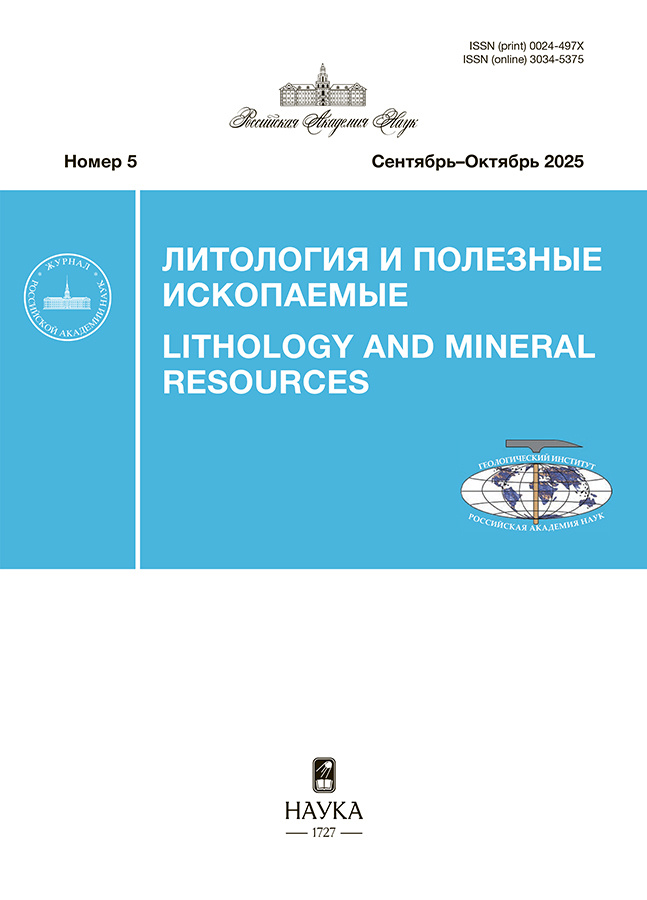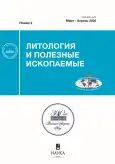Оползневые текстуры осадка в нижнекаменноугольных терригенно-карбонатных отложениях Кочкарского антиклинория (Южный Урал)
- Авторы: Притчин М.Е.1, Кисин А.Ю.1, Озорнин Д.А.1
-
Учреждения:
- Институт геологии и геохимии им. академика А.Н. Заварицкого УрО РАН
- Выпуск: № 2 (2025)
- Страницы: 231-242
- Раздел: Статьи
- URL: https://journal-vniispk.ru/0024-497X/article/view/289074
- DOI: https://doi.org/10.31857/S0024497X25020064
- EDN: https://elibrary.ru/CHIYMQ
- ID: 289074
Цитировать
Аннотация
В состав метаморфического обрамления гранито-гнейсовых куполов Кочкарского антиклинория (Южный Урал) входит нижнекаменноугольная терригенно-карбонатная толща, испытавшая зональный метаморфизм в условиях от эпидот-амфиболитовой до зеленосланцевой фации. Многочисленные деформационные текстуры осадка обнаружены в мраморах названной толщи, вскрытых карьером на Светлинском месторождении золота и в плотике Еленинской россыпи. Основные типы текстур представлены оползнями, связанными с ламинарным течением осадка, реже сейсмитами различной морфологии. Механизм формирования этих текстур связывается с подводным гравитационным оползанием нелитифицированного осадка, вызванным изменением уклона морского дна, и с воздействием землетрясений. Источником сейсмической активности были региональные разломы, ограничивающие антиклинорий, и, вероятно, формирование гранито-гнейсовых куполов. Обнаруженные текстуры оползней и сейсмитов в терригенно-карбонатных толщах обрамления Кочкарского антиклинория дают представление о палеотектонической обстановке его формирования в условиях позднепалеозойской уральской коллизии. Структурное положение карбонатных пород в антиклинории свидетельствует о малой глубине формирования слагающих его гранито-гнейсовых куполов.
Ключевые слова
Полный текст
Об авторах
М. Е. Притчин
Институт геологии и геохимии им. академика А.Н. Заварицкого УрО РАН
Автор, ответственный за переписку.
Email: pritchin@igg.uran.ru
Россия, 620110, Екатеринбург, ул. Академика Вонсовского, 15
А. Ю. Кисин
Институт геологии и геохимии им. академика А.Н. Заварицкого УрО РАН
Email: kissin@igg.uran.ru
Россия, 620110, Екатеринбург, ул. Академика Вонсовского, 15
Д. А. Озорнин
Институт геологии и геохимии им. академика А.Н. Заварицкого УрО РАН
Email: mr.ozornin@mail.ru
Россия, 620110, Екатеринбург, ул. Академика Вонсовского, 15
Список литературы
- Архангельский А.Д. Сернистое железо в отложениях Черного моря // Бюлл. МОИП. Отд. геол. 1934. Т. XII. № 3. С. 431–440.
- Атлас текстур и структур осадочных горных пород. Часть 2. Карбонатные породы / Под ред. А.В. Хабакова. М.: Недра, 1968. 700 с.
- Болтыров В.Б. Пыстин А.М., Огородников В.Н. Региональный метаморфизм пород северного обрамления Санарского гранитного массива на Южном Урале // Труды Свердловского горного института. 1973. Вып. 91. С. 53–66.
- Вассоевич Н.Б., Коротков С.Т. К познанию явлений крупных подводных оползней в олигоценовую эпоху на Северном Кавказе // Труды Нефтяного геологоразведочного института. Серия А. 1935. Вып. 52. 46 с.
- Верзилин Н.Н. Влияние древних землетрясений и мутьевых потоков в меловом периоде на особенности осадконакопления в прибрежных частях Ферганского бассейна // Дельтовые и мелководно-морские отложения. М.: Изд-во АН СССР, 1963. С. 149–154.
- Гаврилов Ю.О. Влияние палеосейсмических событий на строение осадочных толщ и процессы раннего литогенеза в разных по составу отложениях мезозоя–кайнозоя Северо-Восточного Кавказа // Труды Института геологии Дагестанского НЦ РАН. 2017. № 69-2. С. 4–11.
- Геология СССР. Т. XII. Ч. I. Кн. 2 / Под ред. П.И. Аладинского, В.А. Перваго, К.К. Золоева. М.: Недра, 1969. 304 с.
- Горожанин В.М., Горожанина Е.Н. Подводно-оползневые структуры в отложениях янгантауской свиты в Юрюзано-Сылвенской впадине Предуральского прогиба // Геологический вестник. 2019. № 2. С. 32–41.
- Государственная геологическая карта Российской Федерации. Масштаб 1:200 000. Издание второе. Серия Южно-Уральская. Лист N-41-XIII (Пласт). Объяснительная записка / Глав. ред. А.В. Жданов. М.: Московский филиал ФГБУ “ВСЕГЕИ”, 2018. 205 с.
- Деев Е.В., Гибшер А.С., Чигвинцева Л.А.и др. Микросейсмодислокации (сейсмиты) в плейстоценовых осадках Горного Алтая // Докл. АН. 2005. Т. 403. № 1. С. 71–74.
- Деев Е.В., Зольников И.Д., Староверов В.Н. Отражение быстрых геологических процессов в отложениях и текстурах (на примере разновозрастных комплексов Северной Евразии) // Литосфера. 2012. № 6. С. 14–35.
- Кейльман Г.А. Мигматитовые комплексы подвижных поясов. М.: Недра, 1974. 200 с.
- Кейльман Г.А., Болтыров В.Б., Бурьян Ю.И. и др. К вопросу о структурной эволюции Кочкарского антиклинория // Геология метаморфических комплексов Урала // Труды Свердловского горного института. Вып. 91. 1973. С. 38–45.
- Кисин А.Ю., Коротеев В.А. Блоковая складчатость и рудогенез. Екатеринбург: ИГГ УрО РАН, 2017. 346 с.
- Кисин А.Ю., Притчин М.Е., Озорнин Д.А. Геолого-структурная позиция Светлинского месторождения золота (Южный Урал) // Записки Горного института. 2022. Т. 255. С. 369–376. https://doi.org/org/10.31897/PMI.2022.46
- Мизенс Г.А. Седиментационные бассейны и геодинамические обстановки в позднем девоне–ранней перми юга Урала. Екатеринбург: ИГГ УрО РАН, 2002. 189 с.
- Николаева С.Б., Толстобров Д.С., Королева А.О. и др. Гравитационные потоки в позднеледниковых морских отложениях реки Ура (Баренцевоморское побережье, Кольский регион) и их связь с сейсмичностью // Рельеф и четвертичные образования Арктики, Субарктики и Северо-Запада России. 2022. Вып. 9. С. 175–180.
- Смирнов Г.А. Материалы к палеогеографии Урала. Визейский ярус // Труды Горно-геологического института Уральского филиала АН СССP. 1957. Вып. 29. 119 с.
- Огородников В.Н. Сазонов В.Н., Поленов Ю.А. Минералогия шовных зон Урала. Ч. 1. Кочкарский рудный район. Екатеринбург: УГГГА, 2004. 216 с.
- Смолин Д.А. Структурная документация золоторудных месторождений. М.: Недра, 1975. 240 с.
- Сначев В.И., Щулькин Е.П., Муркин В.П., Кузнецов Н.С. Магматизм Восточно-Уральского пояса Южного Урала. Уфа: УОП БНЦ УрО АН СССР, 1990. 179 с.
- Сначев В.И. Петрохимические особенности, условия метаморфизма и рудоносность карбонатных пород Кочкарского антиклинория (Южный Урал) // Нефтегазовое дело. 2022. Вып. 3. Т. 20. С. 6–16.
- Ферштатер Г.Б. Петрология главных интрузивных ассоциаций. М.: Наука, 1987. 237 с.
- Ферштатер Г.Б., Бородина Н.С. Петрология магматических гранитоидов (на примере Урала). М.: Наука, 1975. 288 с.
- Alencar M.L., Correia Filho O.J., de Miranda T.S. et al. Soft-sediment deformation structures in Aptian lacustrine laminites: Evidence of post-rift paleoseismicity in the Araripe basin, NE Brazil // J.S. Am. Earth Sci. 2021. V. 105. 102955.
- Carter D.P., Seed H.B. Liquefaction Potential of Sand Deposits Under Low Levels of Excitation. Berkeley: Earthquake Engineering Research Center University of California, 1988. 119 p.
- Du Y.S. Discussion about studies of earthquake event deposit in China // J. Palaeogeogr. 2011. V. 13(6). P. 581–590.
- He B.Z., Jiao C.L, Cai Z.H. et al. Soft-sediment deformation structures (SSDS) in the Ediacaran and lower Cambrian succession of the Aksu area, NW Tarim Basin, and their implications // Palaeogeogr. Palaeoclimatol. Palaeoecol. 2021. V. 567. 110237.
- Maltman A. On the term ‘soft-sediment deformation’ // J. Struct. Geol. 1984. V. 6(5). P. 589–592.
- Mastrogiacomo G., Moretti M., Owen G., Spalluto L. Tectonic triggering of slump sheets in the Upper Cretaceous carbonate succession of the Porto Selvaggio area (Salento Peninsula, Southern Italy): Synsedimentary tectonics in the Apulian Carbonate Platform // Sediment. Geol. 2012. V. 269–270. P. 15–27.
- Montenat C., Barrier P., Estevou P.O., Hibsch C. Seismites: an attempt at critical analysis and classification // Sediment. Geol. 2007. V. 196(1–4). P. 5–30.
- Moretti M., Sabato L. Recognition of trigger mechanisms for soft-sediment deformation in the Pleistocene lacustrine deposits of the Sant-Arcangelo Basin (Southern Italy): Seismic shock vs. overloading // Sediment. Geol. 2007. V. 196(1–4). P. 31–45.
- Moretti M., Ronchi A. Liquefaction features interpreted as seismites in the Pleistocene fluvio-lacustrine deposits of the Neuquen Basin (Northern Patagonia) // Sediment. Geol. 2011. V. 235(3–4). P. 200–209.
- Owen G., Moretti M. Determining the origin of sof-sediment deformation structures: A case study from Upper Carboniferous delta deposits in south-west Wales, UK // Terra Nova. 2008. V. 20(3). P. 237–245.
- Owen G., Moretti M. Identifying triggers for liquefaction-induced soft-sediment deformation in sands // Sediment. Geol. 2011. V. 235(3–4). P. 141–147.
- Qiao X.F., Song T.R., Gao L.Z. et al. Seismic sequence in carbonate rocks by vibration liquefaction // Acta Geologica Sinica. 1994. V. 7. Iss. 3. P. 243–265.
- Spalluto L., Moretti M., Festa V., Tropeano M. Seismically-induced slumps in Lower-Maastrichtian peritidal carbonates of the Apulian Platform (southern Italy) // Sediment. Geol. 2007. V. 196(1–4). P. 81–98.
- Van Loon A.J. Soft-sediment deformation structures in siliciclastic sediments: An overview // Geologos. 2009. V. 15(1). P. 3–55.
- Waldron J.W.F., Gagnon J.-F. Recognizing soft-sediment structures in deformed rocks of orogens // J. Struct. Geol. 2011. V. 33(3). P. 271–279.
Дополнительные файлы
















